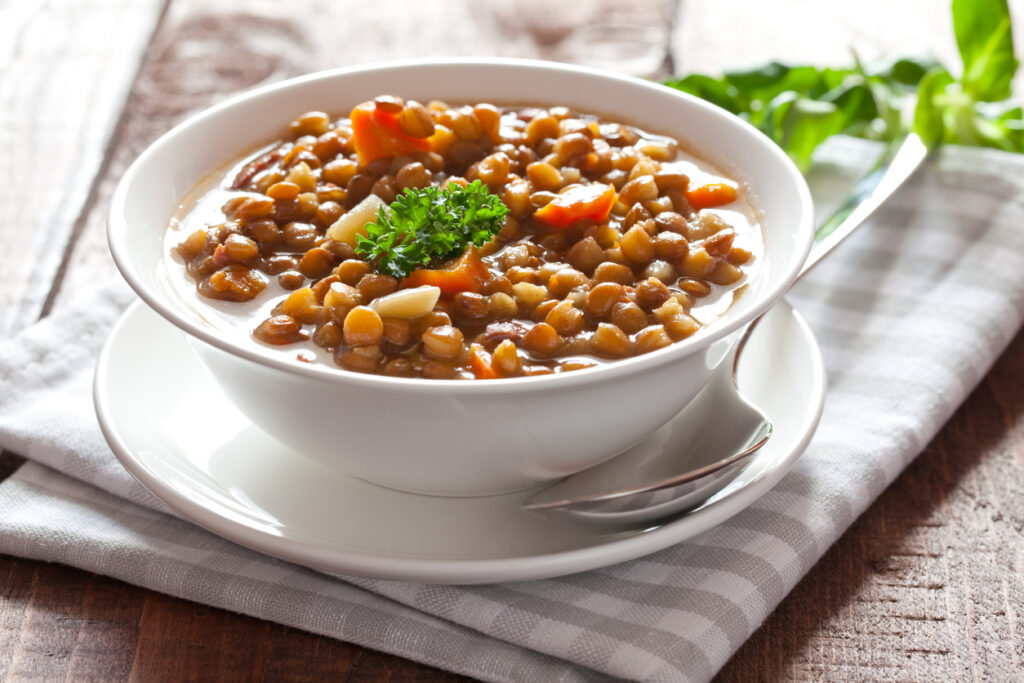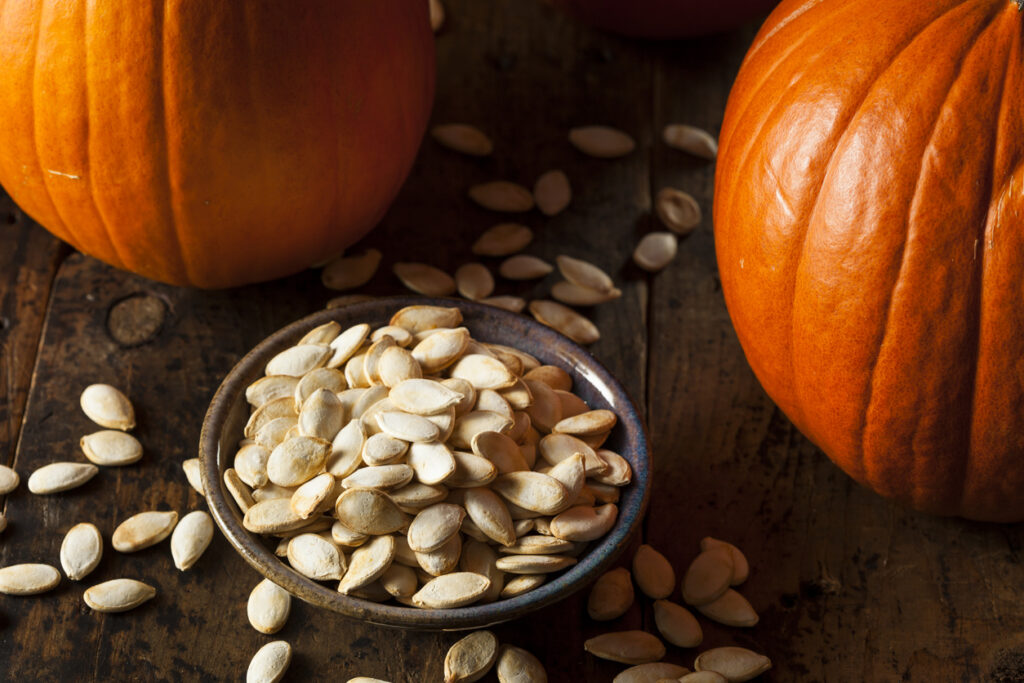1. Lentils

Lentils are a quiet powerhouse. Packed with plant-based protein, fiber, iron, and folate, they help support heart health and blood sugar balance. What makes them a top choice for eco-friendly diets is their incredibly low carbon footprint. Compared to beef, lentils produce 90% less greenhouse gas emissions, and they require significantly less water to grow.
They’re also nitrogen-fixing crops, which means they help improve soil health naturally, reducing the need for chemical fertilizers. This sustainable trait makes them a favorite in regenerative agriculture. From soups to curries and salads, lentils are easy to prepare and incredibly versatile. Incorporating them into your meals once or twice a week can lower your environmental impact and give your body a hearty, nutrient-rich boost. According to Research, lentils rank among the most climate-friendly protein sources available today.
2. Oats
Oats are more than just a comforting breakfast staple. They’re packed with soluble fiber, especially beta-glucan, which helps lower cholesterol and supports gut health. Oats also offer sustained energy without the crash, making them perfect for busy mornings or pre-workout fuel. Their minimal processing and long shelf life make them a pantry favorite for health-conscious eaters.
But they’re also kind to the planet. Oats grow in cooler climates and typically require fewer pesticides and fertilizers than other grains. They’re also water-efficient and have a low carbon footprint compared to animal products or highly processed cereals. Choosing organic oats can further reduce environmental impact. Whether you enjoy them as overnight oats, oatmeal, or even oat milk, they’re an affordable and delicious way to support a sustainable food system.
3. Mushrooms
Mushrooms are a nutritional and environmental win. They’re low in calories, rich in B vitamins, potassium, and antioxidants like ergothioneine, which supports cellular health and may reduce inflammation. Their umami flavor also makes them a great meat substitute in recipes like tacos, burgers, or pasta sauces.
From a sustainability perspective, mushrooms require very little land, water, and energy to grow. They can even be cultivated using agricultural byproducts, like sawdust and corncobs, which would otherwise go to waste. According to Research, producing one pound of mushrooms takes just 1.8 gallons of water and releases less than 0.7 pounds of CO2. Plus, they grow quickly and don’t require synthetic fertilizers. Adding more mushrooms to your diet supports personal wellness and contributes to a more circular, waste-reducing food system.
4. Seaweed
Seaweed is finally getting the spotlight it deserves. Nutritionally, it’s loaded with iodine, magnesium, antioxidants, and fiber, while being incredibly low in calories. It supports thyroid health, improves digestion, and may even aid in blood sugar regulation. Seaweed snacks, salads, and soups are becoming more popular, and for good reason.
Environmentally, seaweed is one of the most sustainable crops on Earth. It doesn’t need fresh water, land, or fertilizer to grow. In fact, it helps remove excess carbon and nitrogen from the ocean, improving marine ecosystems. Seaweed farming has also been praised for creating jobs and restoring coastal biodiversity. Expanding seaweed cultivation could significantly offset global carbon emissions while providing a nutritious food source. Adding a little wakame or nori to your meals could make a big impact, both for your body and the ocean.
5. Chickpeas
Chickpeas, also known as garbanzo beans, are packed with plant-based protein, fiber, folate, and iron, making them a heart-healthy, filling food. They’re also great for blood sugar balance and digestion. Whether tossed in salads, blended into hummus, or roasted as snacks, chickpeas are as delicious as they are versatile.
On the sustainability front, chickpeas are low-impact crops. Like lentils, they’re legumes that enrich the soil with nitrogen, reducing the need for artificial fertilizers. They also require less water than most conventional crops and emit fewer greenhouse gases than meat or dairy. Some sources highlights that pulses like chickpeas play a key role in climate-resilient agriculture. When you swap out meat for chickpeas once or twice a week, you’re not just improving your health, you’re cutting down your environmental footprint, too.
6. Quinoa

Quinoa has earned its spot as a superfood, and not just because it’s gluten-free and packed with complete protein. It’s also rich in magnesium, fiber, antioxidants, and essential amino acids your body needs for muscle recovery and immune support. Its nutty flavor and versatility make it easy to use in salads, soups, or as a hearty alternative to rice.
Environmentally, quinoa is considered a resilient crop. It can thrive in poor soils, high altitudes, and harsh climates with minimal water. This makes it a potential game-changer in sustainable agriculture, especially in regions vulnerable to climate change. However, sourcing matters, look for quinoa that’s ethically grown to avoid negative impacts on native farming communities. Choosing fair-trade or domestically grown options supports both local economies and long-term sustainability.
7. Apples
A crisp apple a day isn’t just good for your heart, digestion, and immune system, it’s also a fruit that can be farmed with relatively low environmental impact. Apples are high in fiber and vitamin C, and their natural sweetness makes them a satisfying snack that keeps you away from processed treats.
When grown locally and organically, apples become even more sustainable. They don’t require extensive transportation, and choosing varieties in season supports biodiversity and reduces emissions. While some commercial farms may use heavy pesticide treatments, many U.S. orchards are shifting toward integrated pest management and organic techniques. Buying local or organic apples from farmers’ markets or regional brands helps reduce your carbon footprint while supporting healthier agricultural practices.
8. Broccoli
Broccoli is a green superhero. It’s loaded with vitamins C and K, fiber, calcium, and antioxidants that support everything from bone health to your immune system. Its anti-inflammatory properties have made it a staple in heart-healthy and anti-cancer diets. Roasted, steamed, or blended into soups, it’s a nutrient-dense option that fits into nearly any meal.
In terms of sustainability, broccoli is a relatively low-impact crop. It grows quickly, doesn’t need a lot of water, and typically doesn’t demand synthetic inputs when farmed responsibly. Plus, it grows well in diverse climates across the U.S., making it a solid local option for reducing food miles. Choosing organic or locally grown varieties helps limit exposure to pesticides and further supports sustainable farming systems.
9. Sweet Potatoes
Sweet potatoes are more than just a holiday side dish. They’re rich in beta-carotene, fiber, and potassium, offering a steady source of complex carbs that support digestion, blood sugar balance, and eye health. Their naturally sweet taste makes them a popular alternative to processed snacks and refined grains.
From a farming perspective, sweet potatoes are hardy and adaptable. They grow well in different soil types, require less water than many other root vegetables, and can often thrive without synthetic fertilizers. They also store well, reducing food waste. Choosing locally grown sweet potatoes supports regional agriculture and reduces your environmental impact. Whether mashed, roasted, or baked into fries, they’re a feel-good food for both your body and the earth.
10. Cabbage
Cabbage might not be flashy, but it’s one of the most underrated health foods. It’s packed with vitamin C, vitamin K, and fiber, and supports gut health, inflammation reduction, and even heart health. Plus, it’s incredibly low in calories and budget-friendly, making it a staple in many traditional cuisines.
Cabbage is also a sustainability win. It grows fast, stores well, and thrives in cooler climates with minimal water. Because it’s a dense crop, it yields a lot of food from a small footprint. Cabbage also requires fewer pesticides and can often be grown without intensive chemical input. Buying from local farms or growing your own makes this crunchy cruciferous veggie an even more eco-friendly choice. From coleslaw to stir-fries, cabbage is as versatile as it is valuable.
11. Barley
Barley might not be as trendy as quinoa, but it deserves a comeback. It’s loaded with beta-glucans, which help lower cholesterol and stabilize blood sugar. Barley is also high in fiber, selenium, and manganese, making it a powerhouse grain for supporting cardiovascular and digestive health. Use it in soups, grain bowls, or as a substitute for rice.
What makes barley environmentally friendly is its adaptability. It grows in cooler climates and needs less irrigation than many other grains, especially rice. It’s also great for crop rotation, helping improve soil health and prevent erosion. Many U.S. farmers already grow barley for animal feed, so boosting its use in human diets could diversify agriculture and cut back on less sustainable crops. Barley’s hearty texture and earthy flavor make it a sustainable, satisfying option.
12. Pumpkins

Pumpkins aren’t just for carving or pie, they’re actually nutrient-dense foods that support immune function, skin health, and vision. They’re packed with vitamin A, fiber, and antioxidants. Roasted, puréed, or blended into smoothies or soups, pumpkins are a fun, seasonal way to eat well and feel good.
Sustainably, pumpkins check a lot of boxes. They grow in diverse regions, store well for long periods, and produce edible seeds, minimizing waste. They also attract pollinators and often require fewer chemical inputs than other crops. Buying whole pumpkins and using every part, flesh, seeds, and even skin, reduces food waste. Plus, eating pumpkins in season supports local farming and cuts down on imported produce, making this autumn favorite a win for both your health and the planet.
